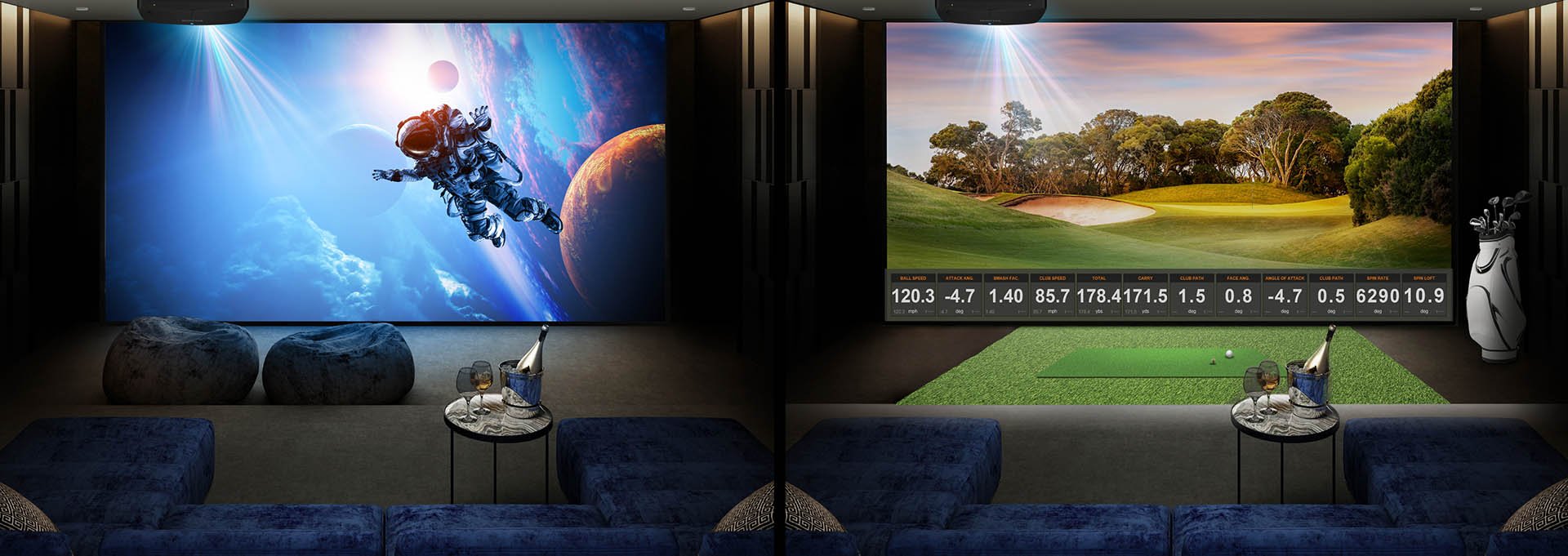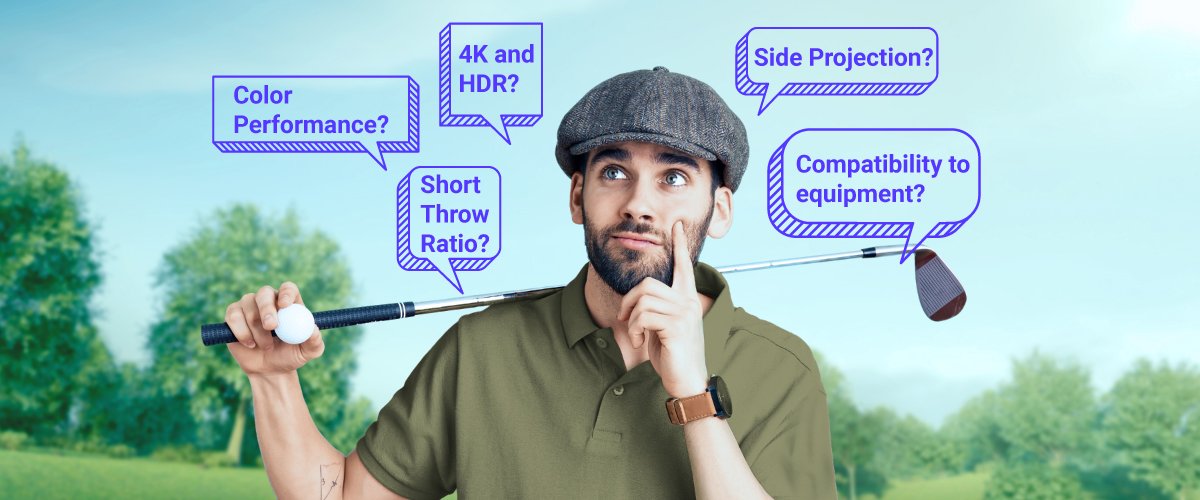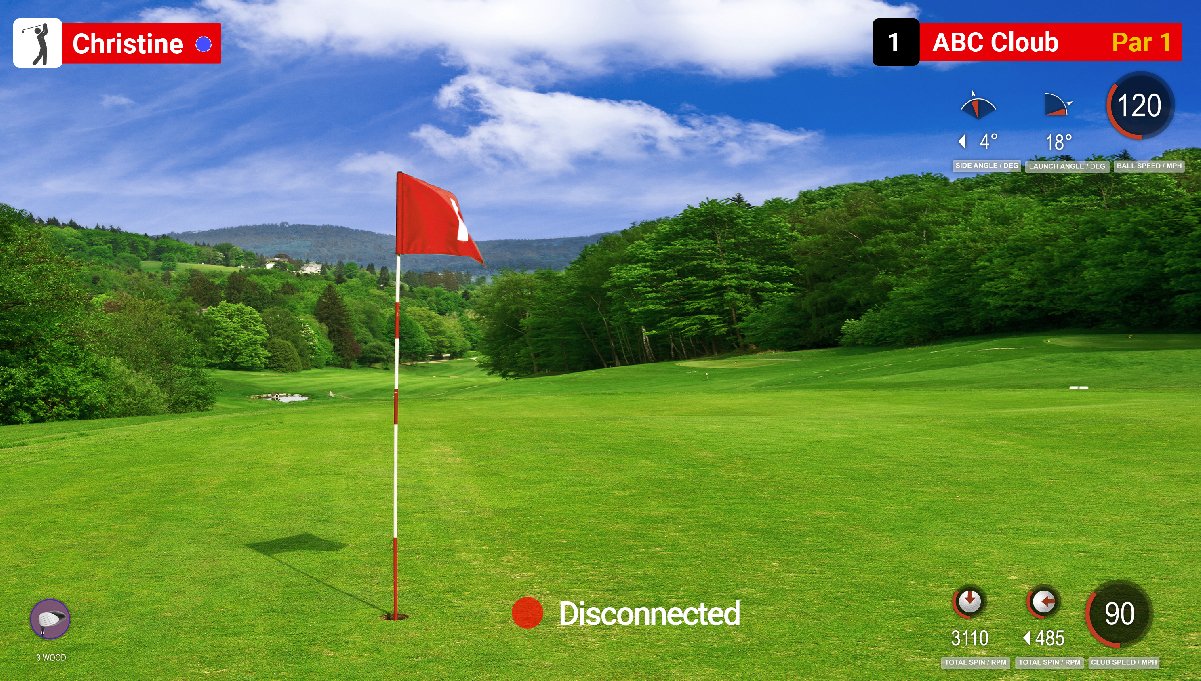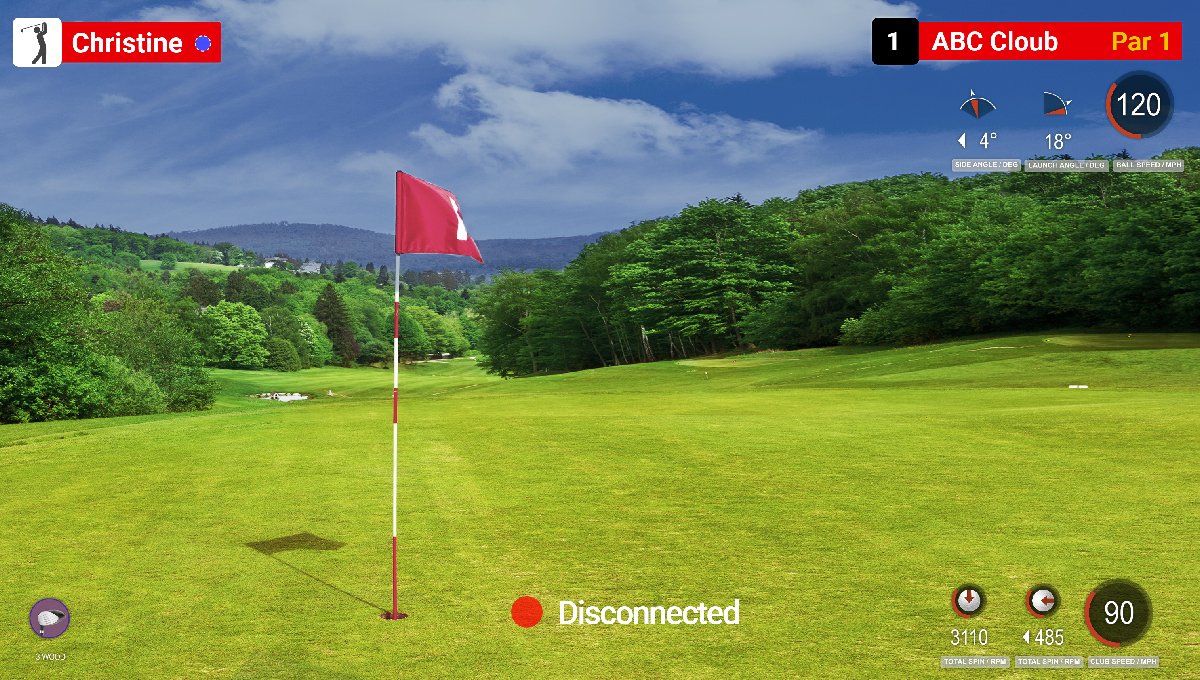Finding a Projector for Both Golf Simulator and Home Theater Use
- 2022-07-06

Beyond the most immediate appeal of making their designated room a dual-use space, the other major reason for building a SimTheater is that it can leverage a significant portion of the hardware used for one purpose towards the other, key among them being the projector. This article will guide golf and movie fans on building an effective SimTheater and what to look for in each component.
What Items are Needed for the Golf Simulator?
To fulfill the demands of the golf simulator side of the SimTheater formula three main components are required: a launch monitor, a computer, and golf simulator software.
Launch Monitor
The centerpiece of every golf simulator is the launch monitor. The launch monitor is the sensor used to measure all the data associated with your golf swing, allowing the simulator to determine where and how the ball will travel in the virtual golf course. There are two main types of launch monitors, each characterized by the technology they employ: the Doppler radar monitor and the camera monitor.
A Doppler radar monitor emits electromagnetic waves whose reflections from the swing lead to the data the simulator uses to build the ball's flight. Some of the more well-known Doppler radar monitor brands include Trackman and FlightScope.
Camera monitors rely on multiple high-speed cameras that record the moment of impact when the club hits the ball and then analyze the images to produce the data for the simulation. Brands that produce more widely used camera monitors include Foresight, Uneekor, and Skytrak.
Computer and Software
A PC and golf simulation software are required to perform two major operations for the golf simulator: to render the virtual golf course where the simulation plays out and to convert the raw data from your launch monitor into a visual representation of the flight of the ball. While most launch monitors come packaged with sufficient software for a basic simulator, avid golfers looking for the most detailed and accurate visuals might want to consider E6 Golf Connect or TGC2019, both of which can pump out simulations in 4K resolution. Once a software suite is chosen, a PC that matches the system requirements for the respective software will then be needed.
What Items are Needed for the Home Theater?
The hardware needed specifically for the home theater portion of a SimTheater depends on the user's preferences. For cinema lovers who enjoy buying and collecting physical copies of the films they want to watch, a Blu-Ray player will be something that they might need to purchase. For those not interested in collecting and/or are more into watching streaming series, they'll only need to get a device such as Google Chromecast, BenQ QS01, Amazon Fire Stick, or Apple TV that can run their favorite streaming services. Additionally, suppose the SimTheater is going to be used for gaming. In that case, you'll need the gaming console you prefer, which in some instances – for example, with a PlayStation or Xbox – can also double as a Blu-Ray player.
What Items can be Shared by Both Golf Simulator and Home Theater?
As mentioned earlier in this article, one of the main rationales for building a SimTheater in your home is the ability to overlap the use of some key pieces of hardware between the two activities, which include the sharing of a projection/impact screen, a sound system, and a projector.
Impact Screen
Impact screens are projection screens that can withstand the impact of the hits that result from the golf simulator. These are screens that are qualitatively different from the average protection screen, with an outer layer dedicated to reflecting the light of the projected image coupled with a thick second (and possibly third) layer tightly meshed to reinforce the absorption capabilities of the screen.
Given that a SimTheater needs to cater to two types of uses, one to keep in mind when selecting an impact screen is to choose a screen that can accommodate a 16:9 aspect ratio and a screen whose fabric won't negatively impact the projected image. One other thing to remember with impact screens is that even though they are specifically built to take hits from golf balls, they still wear down over time and require periodic replacements.
Sound System
To help create an atmosphere that truly immerses the golfer and movie watcher, the SimTheater should have a surround sound system to enhance the audio of their video content; this consists of two types of audio equipment: an Audio/Video Receiver (AVR) and a 5.1 speaker setup.
An AVR is a device that takes in the signals from the various sources described above and then, in the case of the audio, exports them to the SimTheater's speaker system. When looking for a suitable AVR, you shouldn't worry about the types of ports available, as most AVRs on the market feature the input/output ports you'll need. Instead, focus on ensuring they support either Dolby or DTS 5.1 to optimize the SimTheater's sound.
For the speaker system, it's a given that for the type of space used by a SimTheater, a 5.1 surround sound setup (five speakers and one subwoofer) should be used. The bigger issue for this aspect of the SimTheater is the placement of each speaker. We suggest doing some extra planning for this, with special attention paid to having the speakers placed out of the range of your golf swing or the path of the ball, even placing them behind the impact screen as an option.
Projector
The final item shared by the home theater and golf simulator is also one of the most vital pieces of hardware discussed in this article: the projector. Outside of having a suitable dual-use space, the ability to begin thinking about creating an effective SimTheater hinge on having a projector that can simultaneously fulfill the needs of movie-watching on a grand scale and create a compelling golfing experience. To do so, one must find a hybrid projector with specs like the ones described below.

4K Resolution and HDR
Because the nature of a SimTheater is to create an engaging visual experience on a big screen for both the golf enthusiast and movie lover, the resolution of the video needs to match the expanded screen size, meaning, at minimum, a projector with 4K resolution is needed. This will ensure the user can see all the fine details on the greens, as most golf simulation software on the market support 4K video output. Furthermore, users should keep in mind that not all 4K projectors are created equal and to look for native resolution 4K PRO UHD (3840x2160). The projector should also support High Dynamic Range (HDR) so that the action – whether cinematic or gaming – happening in all shades within the frame, from the lightest to the darkest, is as clear as possible.
Color Accuracy and Color Calibration
Another facet to producing truly life-like visuals for golf, movie-viewing, and gaming purposes is the ability to represent all the colors on the spectrum authentically. Therefore, a projector with a color gamut that covers as much of the Rec. 709 industry standard is needed, which means you should look for a projector with at least 92% color coverage of the Rec. 709. Also, some brands provide extra color calibration in custom video modes that adjust the colors to match the viewing scenario. In this case, it's suggested that the buyer compare the colors of each prospective projector and make their selection based on their preferences.
Throw Ratio and Ease of Installation
As hinted at earlier when discussing speaker systems, placement of the equipment is a concern for SimTheaters, which is particularly true for projectors. While normal golf simulators can usually accommodate side installation, for a SimTheater built for golf simulation and home theater purposes, the best bet is to adopt a front ceiling projection setup. This means that one should look for a projector with a short-throw lens since it allows the projector to be mounted closer to the screen than a projector with a normal throw ratio. Furthermore, given a ceiling height of at least three meters, an effective short-throw projector should be installed at least one meter away from the golfer to avoid their swing and any shadows/obstructions on the screen.
It's also suggested that the projector includes lens shift, keystone, and corner fit correction features to easily adjust the projected image for any slight distortions due to the installation location, allowing you to adjust the projected image without diminishing the picture quality.
Audio Compatibility
Because the audio equipment used to build the sound system for the SimTheater may have an array of connection methods, the projector should have a diverse selection of audio output options. In this regard, one should make sure that the projector has at least HDMI, HDMI (ARC), and S/PDIF output ports available so that there won't be any compatibility problems with the audio equipment used.
How the BenQ LK936ST Fulfills Your SimTheater Needs
Finding a hybrid projector engineered with SimTheater use in mind is not easy, especially given all the recommendations above. Luckily BenQ has a "Best in Show" projector that suits such criteria: the LK936ST.
With the LK936ST, you have a projector with true 4K resolution – not the upscaled resolution that some brands use to pass off as "4K" – with HDR visuals and a 16:9 aspect ratio. This ensures that you'll be able to catch every little detail in both the golf course and the movie scene on your big projection screen.
To make the images even more true-to-life, the LK936ST offers 92% coverage of the Rec. 709 color gamut, meaning lush and vivid colors to complement the 4K details of each frame. Furthermore, being a true SimTheater projector, LK936ST features built-in Golf and Cinema (sRGB) picture modes so that you can adjust the color to suit your purpose. For example, the golf mode boosts the greens of the golf course's grass and the blues of the sunny sky to mimic the feel of a day on the greens.

Golf mode

sRGB mode
Beyond the strictly image-based features, the aspect that makes the LK936ST ideal for installation is a short throw-ratio lens that allows you to mount the projector closer to the screen and away from your swing. Supplemented by crucial lens shift, 3D keystone correction, and corner fit capabilities so that no matter how your projector is installed, you'll be able to have an image with perfect geometry. What also makes the LK936ST much easier to install is that we have taken great effort to engineer a more compact and lighter body for the projector, with a chassis that is 30% lighter and 20% smaller in volume compared to its predecessor.
Finally, to guarantee its ability to produce a cinematic sound that enhances the virtual golfing experience, the LK936ST is designed with HDMI, HDMI (ARC), and S/PDIF ports so that you'll be able to connect all the audio equipment you need to achieve 5.1 surround sound.
With everything listed above, the BenQ LK936ST sets a new standard for a hybrid projector built specifically to satisfy the golf enthusiast and film lover at the same time.
Recommended Articles
-
Trends & Knowledge
How the right projector can perfect your Full Swing golf simulator
A guide to choosing the best projector for your Full Swing pro-series SimTheater and feel like you are playing Torrey Pines – or play 13 sports including football, soccer, baseball, and even zombie dodgeball with ultimate realism.
2022.01.11 -
Trends & Knowledge
What is the perfect golf simulator projector for SkyTrak?
The best projector for SkyTrak Golf Simulators for any budget
2021.05.17 -
Trends & Knowledge
Build a home golf simulator with the perfect projector
This article guides you through what you need to know when building your own golf simulator, including some tips about how to choose the right projector.
2021.04.20 -
Trends & Knowledge
How to pick the right golf simulator projector?
What to look for in a projector when choosing the perfect one for your golf simulator. Check out why we recommend BenQ Bluecore Laser Projector as the best golf simulator projector.
2021.05.17 -
Trends & Knowledge
Why a 4K laser golf simulator projector is the best choice?
Learn why a 4K projector is the only way to properly simulate your favorite course. From the way the flag is blowing to how the green lies, every detail matters.
2021.05.17